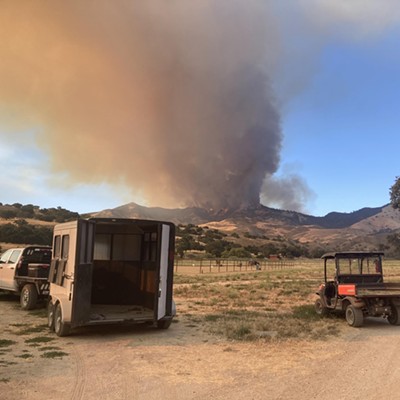From helping manage record-setting storm damages to raising the benchmarks for Big Oil, Gregg Hart jumped right into his role as the Assembly member for the 37th District, representing Santa Barbara County and southern SLO County.

“I feel like my first year was very successful, particularly as a new legislator,” Hart told the Sun. “The first big challenge was that I [was] used to a local government level—five supervisors, seven City Council members—what you need to be successful is a simple math problem.”
Working with 80 Assembly members and 40 state senators made getting legislation passed more complicated and daunting, so Hart helped launch the first Central Coast Caucus—which includes 10 representatives from Ventura to Santa Cruz counties.
“Having 10 legislators has really improved the visibility in our area, and I think that will have an impact with the budget and laws because we are speaking with a unified voice,” he said.
He helped allocate $8 million in state funding toward local projects, and eight of his bills will go into effect on Jan. 1, 2024. He also opened the first North County office for state representatives in Santa Maria.
“Having an office in Santa Maria will be really critical to our outreach and providing constituent services in North County. We don’t want people to have to drive to Santa Barbara to access our time,” he said.
Storm recovery
In Hart’s first month as a legislator, record-breaking winter storms drenched Santa Barbara County.
“It was very intense and a really difficult time here. The county was looking for help from the government and to declare our area a natural disaster,” Hart said.
Hart advocated for a county project that would help realign the Santa Maria River and install a levee in Guadalupe, but the state couldn’t approve it because of the cost-to-benefit ratio—which looks at the cost of the project versus the cost of what it would be protecting.
“It was a bitter pill to realize there was no path for what the county was trying to accomplish with an existing funding allocation,” Hart said. “The scope of disaster assistance is limited. There isn’t enough money to fix every situation, and this year was particularly dire because rains and floods were pervasive across the state.”
In August, Gov. Gavin Newsom issued an executive order to allow local agencies to work in waterways in order to remove debris before Nov. 1. Knowing the county would not be allocated funding and they were still waiting for an official response, Hart contacted county officials directly to let them know that if they wanted to take any preventative action, they needed to act immediately, he said. After Hart’s advice, the county invested $8 million in a debris and sediment removal project.
“Doing what the county’s doing, they are going to prevent an environmental disaster in the future, and there has to be a way to fund that,” Hart said.
While there are bond measures that try to address disaster preparedness in the legislative process, the state doesn’t have the money to cover all the measures, Hart said. Those measures will need to be narrowed down, but Hart said he’ll advocate for as much funding the state can afford.
Housing and nonprofits
The housing supply-demand imbalance is causing home prices and rents to rise “beyond the ability of working people to afford,” Hart said, and the state has been pushing local governments to build more housing.
As Santa Barbara County works to approve its Housing Element to plan for development through 2031, Hart said he’s noticed less resistance because he thinks people are recognizing the severity of the crisis and how it relates to homelessness.
Housing people first is key to alleviating homelessness, a lesson Hart believes the county is learning through the Dignity Moves housing projects in Santa Barbara and Santa Maria.
“Those are really powerful examples of what we can do to really quickly build affordable housing and get them the services they need to get people back on track, and that model is what we need to be doing statewide,” he said.
The California Senate introduced a bill in February that would open up vacant land across the state for “opportunity housing projects” similar to Dignity Moves, but the bill is still being amended, according to LegiScan.
In order to support nonprofits that serve California’s most vulnerable communities, including individuals experiencing homelessness, Hart authored a bill that would allow nonprofits receiving a state grant or contract to get 25 percent of their payment in advance, he said.
Nonprofits rely on reimbursement models and are often forced to take out loans to cover costs while they wait for state grants and contracts to begin, with one nonprofit paying $28,000 in interest while waiting for state payments, according to Hart’s office.
“That’s a big problem for nonprofits, getting compensated [from the state] takes six to eight months and … it prevents a lot of nonprofits from moving forward on state grants,” he told the Sun.
Hart said he worked with the California Nonprofits Association, which lobbied for a package of bills, but only two were signed into law. He added that he’s hoping to work closely with the association and advance more bills in the next legislative cycle.
Big Oil regulations
While Hart was still sitting on the Santa Barbara County Board of Supervisors, he watched Greka Oil Company wreak havoc on the county, go bankrupt, and abandon its wells—leaving the state with the cleanup bill and the largest oil cleanup project in state history.
“They were a really bad operator and didn’t invest in maintaining their equipment and facilities, and it was extremely difficult to get them to be responsive to the regulatory agencies,” Hart said.
The oil company—which spilled about 1.1 million gallons of crude oil and abandoned 171 unplugged wells—was the impetus for AB 631: one of Hart’s bills that was signed by the governor. It updates oil regulations and increases penalty fees for violating the law, he said.
“The state regulatory penalty system isn’t modern, it’s an artifact,” Hart said, adding that penalty fees didn’t make much of an impact on multimillion-dollar oil companies.
“There are other regulatory agencies that have much more consequential penalties. The idea was to model those other structures and bring those up to date,” Hart said.
According to ProPublica, the California Geologic Energy Management Division (CalGEM)—the state agency that oversees oil and gas production—issued 66 enforcement orders between 2018 and 2020, with only 11 orders reaching compliance. In 2020, CalGEM issued more than $190,000 in civil penalties and failed to collect a single dollar.
“The taxpayers end up picking up the tab on that situation and it’s not right. There’s no way this should be the outcome,” Hart said.
The bill allows CalGEM to refer cases to local district attorney’s offices for more effective enforcement, he said. It also allows CalGEM to seek injunctive relief from a Superior Court to compel operators to correct violations that, if persistently neglected, can deteriorate into worsening conditions that could threaten public health, safety, and the environment.
“Ideally, it would sharpen the proactive response that companies would build into their infrastructure so they would understand the consequences are serious,” Hart said. “It can’t be the cost of doing business, you have to comply.”
Reach Staff Writer Taylor O’Connor at [email protected].











